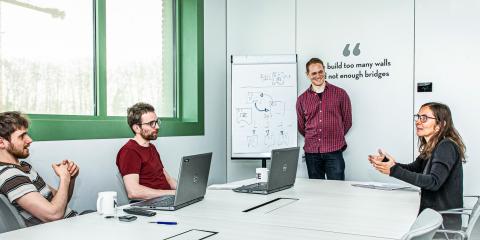Collaboration for Accelerating Innovation: 4 good reasons to go for it

Collaboration for Accelerating Innovation: 4 good reasons to go for it
We are living in a rapidly changing environment where competition is fierce. As a result, companies need to look for ways to make sure they capture the relevant technologies and knowledge and to ensure fast product developments to stay ahead of the competition. In other words, companies need to accelerate their innovation processes to ensure sustainable success.
No single company, SMEs nor large corporations, can still innovate based solely on its own resources and internal ideas. It is thus absolutely essential to install an open innovation culture leading to collaboration with different actors within the region and even beyond. Such culture should aim at systematically incorporating open innovation tools to promote a change of mindset and to strengthen the links between research partners on the one hand and production companies on the other. This is a prerequisite for maintaining and increasing the speed of innovation, thus guaranteeing sustainable success on the market. Such collaboration will also create additional employment and encourage innovative activities among SMEs.
There are several reasons for embarking on this journey. These are the 4 most important ones:
1. Integration of new (out-of-the-box) ideal for your products and applications
New technologies are coming on the market at an ever-increasing speed. As a result, companies need to spend a considerable amount of time not only to follow up technology and knowledge developments, but also to assess the relevance and usability of these developments for their own applications.
Setting up partnerships – embedded in an innovation ecosystem and covering the full TRL scale – with knowledge actors that have close links with and work within a large industrial ecosystem, can help companies to reduce the time needed for technology follow-up and to make substantiated assessments regarding the relevance for their own applications.
2. Speeding up digital transformation
Next to upgrading products with functionalities based on new technologies, resulting in better products that are better customised to specific customer needs, companies should also seize the opportunities provided by digital transformation to accelerate customisation, exploit the full potential of data and derive actionable insights for creating added value to both the customer and the company. For most companies, this is a new domain in which they have no or only limited experience. Companies not only need to upgrade their strategy for setting digital transformation objectives, the implementation also requires them to partner with third parties for selecting, executing and, subsequently, scaling appropriate pilot projects to ensure that added value is captured and to enable a fast and reliable innovation track.
Ultimately, this transformation may lead to a new or complementary business model, e.g. x-as-a-service, the exploitation of data to acquire insights into the use of the product by customers. These data will contribute to implementing (semi)-autonomous functions based on actionable insights acquired through the use of explainable, hybrid AI or digital twins, which will allow to predict the behaviour of products and production plants and will thus result in the improved operation and maintenance of the assets installed at the customer’s.
3. Shortening time-to-market of products
Using internal (e.g. maintenance & production departments) and external partners (e.g. knowledge actors, value chain companies, suppliers) can shorten the time-to-market.
The internal partners support the product development with new ideas and can incorporate their knowledge related to production technologies for speeding up the transfer of the product from R&D and engineering to the production floor and to improve product manufacturability. Maintenance employees can bring in their field experience, creating additional value for customers by improving the maintainability and customer experience. When the company uses an XAAS model, this will also reduce the maintenance costs and result in higher margins.
The external partners, on the other, will make it possible to include new ideas for creating better products. They are not pre-biased and are more open to out-of-the-box thinking. They can use the experience gained in other sectors to accelerate the introduction of new technologies and/or the application of existing knowledge. Their external views may also question current internal practices, leading to new development processes.
4. Extending the company's digital talent capacity and boosting knowledge about new technologies
Companies have limited digital talent capacities and competences in terms of innovation. In most cases, smart selections are made to ensure the best possible use of the digital talent available while hoping not to miss a major trend.
Today, a fast-track digitalisation journey requires companies to upscale their digital talent capacity and competences as more innovation areas need to be covered. On the other hand, the pandemic has learned that downscaling should be possible in case of an economic downturn. The solution for both situations is again collaboration with third parties based on long-term, yet flexible agreements.
Involving knowledge actors in innovation projects will increase the company’s talent capacity and competences without over-staffing the company. Of course, the balance between own staff and external staff on a project should be monitored. Up to a 50/50 balance is feasible for strategic innovation projects. This ensures a knowledge transfer in terms of technology and research methodologies from the knowledge partner to the company, but also a transfer of application knowledge from the company to the knowledge partner. This bi-directional transfer is beneficial to both partners and very important for long-term partnerships. It boosts learning among staff through the joint execution of projects, thus upgrading the competence levels of the company’s digital talents in a fast, effective and efficient way.
